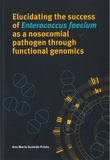Elucidating the success of Enterococcus faecium as a nosocomial pathogen through functional genomics
Summary
Enterococcus faecium is a Gram-positive bacteria and a common commensal of the gastrointestinal tract. However, E. faecium can cause a large number of hospital-acquired infections in humans and has rapidly acquired resistance to several classes of antibiotics. The ubiquitous nature of E. faecium, the ability to prosper in complex microbial communities, the great flexibility of its genome and the global use of antibiotics, are important factors driving E. faecium’s current emergence as a nosocomial pathogen around the world. The rise of vancomycin resistant enterococci (VRE) particularly complicates treatment of infections caused by enterococci in hospitalized patients. Unfortunately, up to date, only few new antibiotics have been introduced for clinical use to treat VRE infections.
It is of essence to understand the epidemiology and phylogenetics of E. faecium to help contain its current global rise as a nosocomial pathogen. To this aim, diverse molecular tools have been developed since the year 2000. The advent of whole genome sequencing has allowed more accurate studies on the population structure of E. faecium. The species E. faecium can be divided into three distinct sub-populations that each include the majority of clinical isolates, strains from healthy humans and animal isolates. The acquisition of adaptive elements, such as mobile genetic elements carrying antimicrobial resistance and virulence determinants, contributes to E. faecium’s success as gut commensal and nosocomial pathogen. For some time, the lack of suitable methods for genomic studies in E. faecium hindered the functional characterization of genetic determinants that are relevant to important E. faecium traits. Fortunately, these barriers have largely been removed over the last few years. In this thesis, we continue to expand the use of high-throughput approaches to characterize the genetic determinants of E. faecium that can explain its success as a nosocomial pathogen.
To successfully colonize and infect the host, E. faecium has to gain access to underlying tissues, which are exposed when natural barriers, like the skin, are breached by trauma, surgery or the use of small indwelling medical devices like catheters. In E. faecium, surface proteins anchored to the peptidoglycan can recognize host extracellular matrix components (ECM). In chapter 2 we performed comparative transcriptome profiling of an ampicillin-resistant E. faecium isolate grown at mammalian (37°C) and room temperatures and identified a thermo-regulated surface-exposed protein, termed PrpA. We showed that its functional N-terminal domain interacts with fibrinogen and fibronectin, which are components of the ECM present in mammalian hosts. The same domain was also able to bind to platelets. This thermo-regulated surface-exposed protein was found to be produced at 37°C in clinical and animal strains but not at room temperature or in commensal isolates.
Central lines in hospitalized patients create an access route for bacteria to reach the bloodstream, causing bacteremia and other central line-associated bloodstream infections (CLABSIs), which are common in critically ill patients. The use of disinfectants for daily patient bathing, is effective in reducing CLABSIs, particularly in reducing the risk of VRE infections. Chapter 3 describes a two-component system, identified through a microarray-based transposon mutant screening method, implicated in tolerance to the disinfectant chlorhexidine. In addition, we showed that this putative two-component system is also implicated in resistance to the antibiotic bacitracin, which may be used in the treatment of VRE colonization and infection.
Bloodstream infections can result from translocation of pathogens from the intestinal tract into the bloodstream or by fecal contamination of the skin, followed by a breach in this barrier, e.g. when a catheter is placed. In either case, E. faecium needs to overcome the insufficiency of basic nutrients in the bloodstream, to be successful in such niche. In chapter 4 we sequenced the genome of the vancomycin-resistant clinical E. faecium isolate E745 and implemented a high-throughput transposon mutant sequencing approach, to perform a sequencing-based genome-wide functional profiling of this strain. We identified the genes that contribute to survival and growth of E. faecium E745 in human serum, showing that genes involved in carbohydrate uptake and genes involved in the biosynthesis of purine and pyrimidine nucleotides, had a role in this phenotype. Transposon mutants in selected genes were isolated from the mutant library and were shown to have a growth defect in human serum and found to be attenuated in virulence in a zebrafish infection model.
The rise of VRE and the difficulties that are posed by the treatment of infections caused by these bacteria, highlight the need for the development of new antibiotics. Meanwhile, the implementation of different antimicrobial therapies using relatively novel broad-spectrum antibiotics and combinations of antibiotics needs to be explored. Unfortunately, resistance remains a concern with these therapeutic approaches. In chapter 5, we describe a novel resistance mechanism against the recently introduced antibiotic tigecycline. Resistance was caused by mutations in the rpsJ gene which encodes a ribosomal protein. This mechanism was identified using a combination of comparative genomic analysis of paired susceptible and resistant isolates, and functional genetic complementation.
The widespread use of antibiotic in human and veterinary medicine is a crucial factor in the emergence of succesful E. faecium clones that have adapted to live in the hospital. However, other traits, like the ability of the bacteria to colonize the intestinal tract and cause infections, are also important to explain the transition of E. faecium from gut commensal to nosocomial pathogen. The research described in this thesis contributes to our understanding of the underlying mechanisms that have made E. faecium an important nosocomial pathogen and may contribute to the development of new therapies aimed against this bacterium.
